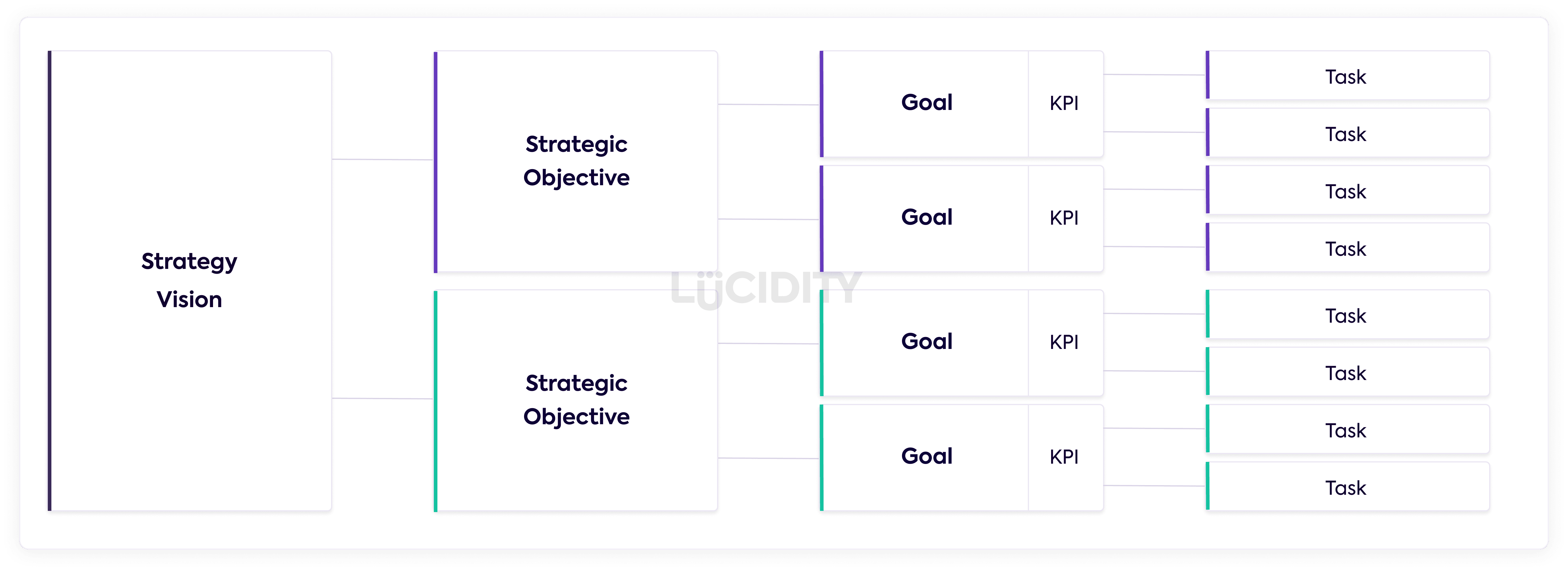Creating a strategy plan for your business isn’t a small task. It takes time and effort (albeit, less time and effort if you use Lucidity 😉). So, it’s important that you don’t then fail to communicate that plan properly to your people and kick-off the execution in the right way.
Communicating the strategy is where a lot of companies go wrong. It can be the absolute pivotal step between having a strategy plan and successfully executing it. Get it right and your people will understand exactly what you want to achieve, why it’s important, how you’re going to make it happen, how they contribute, what they need to do and when. They’ll be motivated and driven to make the strategy a reality.
If you get the communication wrong, your strategy will be, at best, forgotten, at worst, never understood in the first place. Your people will fail to read your long email, or struggle to stay awake in your two-hour-long presentation and then they’ll go back to their desks and carry on with what they were doing, exactly how they were doing it. Your plan won’t get executed and your goals will not be hit. Your business won’t grow and your strategic planning work will be wasted…. OK, I’ll stop now, you get the point.
Remember, getting your strategy communication right will mean your people internalize the strategy and that will then influence the experience they create for your customers.
So, here are our 12 steps to ensuring you nail the communication of your strategy and set yourself up for effective execution and business success.
- 1. Involve your people
- 2. Have an inspiring vision
- 3. Use a clear structure
- 4. Launch it right
- 5. Show the context
- 6. Give everyone access
- 7. Show everyone how they contribute
- 8. Don’t stop communicating
- 9. Maintain visibility of progress
- 10. Encourage feedback and discussion
- 11. Train your managers to make it part of the everyday
- 12. Nurture your doubters
Let’s look at each step in detail…
1. Involve your people
This is really something to think about for the stage before communication of the plan. You need to consider this as you build and create your strategy. It’s about getting as many people from across the business as you can involved in the process of devising your strategic plan.
Now, we’ve not advocating getting everyone involved at every stage. We understand that, for the most part, strategic planning needs to be led and conducting by the leadership team and that too many cooks could slow the process down and ultimately hinder your progress. But, it’s a good idea to select certain areas of the strategy formulation process that could be opened out to more people from across the business.
Look at our advice for increasing participation when it comes to formalizing your company values or creating your vision statement, but also think about other areas that could benefit from wider input.
The benefits of increasing participation in the strategy formation include:
- More people talking about the strategy in the business – increasing word-of-mouth
- A greater feeling of being invested for more people
- More awareness across the business of the background and context of strategic decisions
- A wider spread of knowledge and experience influencing the strategic planning
- Insight and guidance on how best to convey the plan so it makes sense to the teams on the ground
You might also want to create a cross-functional strategy team out of these people who had early involvement. This group of people could act as the strategy champions across the business and help you spread the word, communicate the plan at team level and prevent the communication of the strategy being just top down.
2. Have an inspiring Vision
Before you get into the detail of the strategy with everyone, first you need to capture their attention. This is where your Vision Statement comes in. One clear, inspiring statement that sets out your purpose and ambition.
Don’t underestimate the importance of a vision statement. It really is the first point of interaction most of your people will have with the strategy, so it needs to make an impact.
It should paint a picture of the future you want to get to. It should clearly state the difference your organization wants to make in the world. This is not the time for modesty or humility – think big, be bold, go large. You want to motivate people by describing a positive, meaningful future that they can be a part of.
Your vision statement is the first thing to communicate when it comes to your strategy. This is where you start, showing everyone where you want to get to, why you want to get there and why it matters. It’s the big, overall ambition for the organization and end-goal of the strategy you’re about to map out.
So, you’re starting with what you want to achieve as a company…. Then you’ll move onto the details and the how.
You may want to consider splashing your vision statement around the physical environment your teams work in, or have it front and centre in the virtual environment you all interact in. Whatever your working environment looks like, think about how you could incorporate a visual of your vision statement to keep it front-of-mind for everyone.
For more guidance on how to craft your vision statement and to see hundreds of examples from real businesses, check out our Ultimate Guide to Vision Statements.
3. Use a clear structure
Once you’ve captured the attention of your people with an inspiring vision it’s time to get a little more specific and show the plan for how to reach that future state.
However, it’s important not to get too detailed too soon. If what you’re mapping out starts to sound overly complicated people may well switch off or drift off. The more detail you go into, the longer it will take and the higher the chances that you’ll lose people’s attention.
The focus should be on conveying the plan on one page. A good structure will not only give you the framework through which to talk about your plan, it will also give you a clear visualization to bring it to life.
Use a tried and tested structure – a lot of time, effort and testing has gone into devising effective approaches to structuring a strategy plan, take advantage of that. There are a number of existing frameworks to help you map out your strategy plan like VMOST or the OGSM Framework. Here at Lucidity, we use a Strategy Tree and if you build and communicate your plan in our software, you’ll find it quick and easy to lay out your plan in a logical, easy to understand way. You can find out more about the different options by reading our list of the Best Strategy Tools to Structure Your Plan.
But, as I say, here at Lucidity we believe the clearest way to structure your strategy is with a Strategy Tree.
The components of your Strategy Tree are:
- The Vision – which we’ve already talked about
- Your Strategic Objectives – these are the major things you want to achieve as a business, the broad, high-level things you want to make happen
- Goals & Initiatives – these are the specific things that need to happen in order to achieve those strategic objectives. Goals are exact targets with clear measures (giving your KPIs a target to hit) and Initiatives are those supporting, often ongoing projects that need to happen (but are possibly less measurable)
- Tasks – the individual jobs that need to be done in order to hit the goals or launch, progress or complete an initiative
4. Launch it right
Of course, even the most clearly structured strategy plans will fail to be engaged with and understood if they’re not presented well. The best vision statement in the world can be overlooked if it’s just emailed around to ‘all’ and sitting at the bottom of a long corporate communication. The best one-page strategy structures can get lost if they’re in amongst hundreds of other pages in a chunky document. So, once you have a strong vision and a nicely structured strategy, you need to consider how best to showcase that to your people.
Options for that first presentation of the strategy:
- A large ‘all-hands’ presentation to the whole organization
- A ‘roadshow’ where you present to smaller groups, running departmental sessions
- Videos to email round, post on your intranet and share on your messaging system
- Open door sessions for anyone to come and ask questions
Probably, the answer is a combination of all those approaches. It’s best to run a series of different presentation styles so everyone’s preference for consuming information is covered and you stand the best chance of hitting the mark with the majority of your people. That will also mean there are more dates available to find out about the strategy giving everyone a chance to make at least one session.
However you chose to ‘launch’ the strategy for everyone, make it different to your standard internal communications so it stands out. And give it it’s own billing – don’t include it in a regular meeting or a regular communication. If you make it it’s own ‘thing’ then you’ll be highlighting it’s significance and importance.
5. Show the context
Another top tip when it comes to communicating your strategy is to include the background. Take people on a journey, tell a story, show people how you got to this particular set of strategic decisions. This will help them understand why this is the plan and help reinforce the importance.
Showing how you’ve reached these strategic decisions will also help the plan feel less top-down – less like an order. You’re not asking people to just blindly follow the plan, you’re taking the time to show them why you’ve reached these decisions.
We’d recommend taking people through some of the workshop outputs that got you to this strategy. Consider presenting a visual of your SWOT Analysis, your PESTLE, the work you did with the Ansoff Matrix to help assess the different strategic options, for example.
Paint the competitive landscape for them so they can see how your strategy fits in with the rest of the market. Possibly show a Perceptual Map, a Four Corners Analysis of a key competitor, or any other competitor analysis you may have done.
Just remember to not get overly complicated at this stage – stick to the most easily digestible frameworks and tools like simple matrix models that offer succinct summaries.
6. Give everyone access
It is all too common for strategies to be presented to employees with a big bang…. But then hidden away in files and folders, either completely inaccessible, or very hard to find. It’s no good creating fabulous visuals and slide decks, to then have them filed away where they’re not seem again until the next big meeting.
It’s so important that your strategy is a living, breathing plan – always up to date and always available. You want your people to be able to look at the strategy, refresh their memory, refer to the detail, whenever they need to. And if it’s hard to get to that information, chances are people will give up. You don’t want their first attempts at proactively engaging with the strategy to be difficult and time-consuming, that will taint their perception of the whole process.
So put your plan where everyone can easily access it and don’t allow it to be static – keep it up to date with progress, milestones, comments and results.
This is one of the fundamental differences Lucidity can make – putting that strategy plan somewhere easily accessible and automatically up to date so you can be confident everyone is looking at the right information.
7. Show everyone how they contribute
Even at the stage where you’re first ‘launching’ the strategy to the teams, you should try and describe the strategy right down to task level. We’re not saying that every goal or initiative needs to have all its component tasks mapped out from the very start (and obviously going into each and every task would be far too detailed for that first presentation), but it would be worth having an example task or two ready for a selection of your strategic goals so you can illustrate the end-to-end approach and help people envisage where their contribution comes in.
There’s a danger, if you don’t take your overview down to task level that the strategy will feel disconnected from your teams’ day-to-day work. Without illustrating the ways their individual tasks link back up to the overall strategic objectives there’s a chance your people will perceive the strategy plan as something the leadership will focus on while they get on with the usual stuff.
So, show everyone that there are, or will be, very specific tasks with deadlines and owners attributed to each and every goal and initiative associated with the strategic objectives. Taking it to this level will also enable you to put timeframes around all of your objectives, goals and targets.
8. Don’t stop communicating
After the big ‘launch’ of your strategy, even if you’ve put the plan somewhere central and easily accessible, you should keep coming back to it and presenting the progress you’re all making.
So, you should consider how frequently you want to get everyone together again and talk strategy as a company. We’d say the more frequently the better. Don’t just do it once or twice a year, make it a fundamental part of every all-hands session you run. This will help embed the strategy throughout the business and leave no one in any doubt about the importance you’re placing on it.
9. Maintain visibility of progress
Use these regular and frequent sessions to present the ongoing progress of the strategy. Reiterate the plan, but focus on what milestones are being met, what major tasks are being completed and what deadlines are being hit. Motivate your people by celebrating the small wins along the way.
One nice idea for these progress presentations would be to get a team to present the progress they’re making in their area – maybe invite a different team each month. This would be another good way to stop the strategy feeling overly top-down and it would also demonstrate and celebrate the contributions of the teams on the ground.
Do not confine progress updates just to presentations though. If you’ve done what we suggest in point 6, you’ll have put your strategy plan somewhere central and available to everyone – now you need to make sure all the progress and results are clearly visible and up-to-date in that central place so that every time someone checks in on the strategy they’re seeing the latest picture.
Consider a software that links your strategy plan to a task management system and integrates with your business intelligence systems to automatically track KPIs and monitor goal progress. Dashboards and automatic reporting are also important tools for getting that instant visibility of progress in an easily digestible way.
10. Encourage feedback and discussion
You need your people to engage with the strategy, not just listen to it. Opening up channels for feedback, comments, discussion and input are a great way to ensure everyone is given a chance to share their views and interact with the plan.
Showing the teams that you want their thoughts and feedback will help everyone feel involved and reduce the perception of the plan being dictated, top-down.
Ways to encourage feedback:
- Run drop-in, open door sessions with the leadership team for the purpose of asking questions and sharing views
- Create a channel in your internal messaging system for people to post into
- Use a strategy software with a built-in communication feed that allows comments and reactions
- Have all managers ask their team members for comments and questions on the strategy during their regular one-to-ones
If you are going to gather thoughts and comments on the strategy, be sure to do something with that feedback. Make sure you’re open to exploring any interesting ideas that come from the teams and acknowledge the points that are made – especially where you see common themes appear.
Maybe use some time during your regular strategy presentations to address questions that have come in over that month or quarter.
11. Train your managers to make it part of the everyday
As we’ve said throughout this article, getting strategy communication right is all about frequency and accessibility. You cannot effectively embed the strategy through your organization if people only hear about it from the senior leaders during a couple of big presentations. Nailing this depends on how effectively you can make strategy part of the everyday working life of your people.
Your managers will play the crucial role here. You need to turn your management team into a group of strategy champions who are all fully informed, knowledgeable and capable of answering questions, reinforcing the priorities and translating the strategy into tasks for their teams.
We’d suggest creating a training program that all line managers go through to ensure they’re fully up to speed on the plan and your expectations for how it will influence their day-to-day people management. That could be anything from a few workshop sessions to a series of videos to watch. The important thing is that you take the time to ensure all the team managers in the business know their stuff when it comes to the strategy.
Then be very clear about how you expect them to integrate the strategy into their interactions with their teams. That could be things like….
- Refer to the strategy and review task progress in each and every 1-2-1
- Run regular team sessions where they review the strategy and their team contribution
- Ensure workload is prioritized in line with the strategic objectives and goals
- Base their performance feedback, praise and reward on contribution to the strategy
12. Nurture your doubters
Unfortunately, you won’t win them all. It’s near impossible to please everyone. Even if you follow all these steps you won’t automatically get everyone onboard, some people just won’t be up for it.
Now, some of these doubters may be very vocal about their reservations (especially if you’re welcoming and encouraging feedback and discussion), but some will stay quiet and just refuse to engage. In both cases, it’s worth giving them some time and attention to try and win them over and mitigate the negativity.
You’ll need to seek those quiet doubters out as they’ll be harder to spot. Get your managers to identify who in their teams aren’t into the plan and then reach out to them – not in a confrontational way, but to get their thoughts and feedback. Don’t make them feel that they’re being singled out or that it’s some sort of performance black mark, just that you’re dedicated to having a strategy that people believe in, so you’re interested to hear how you could make it more engaging.
Even if you can’t convince them of the validity if the strategy, they’ll feel positive about being heard and that their views are valued.
Final thoughts
So, those are our top 12 tips for getting the communication of your strategy right. It’s all about making it clear and easy to understand and truly making it part of the way everyone works each day. If you follow these steps and release your strategy from files and folders, putting it where everyone can see it and interact with it, you’ll vastly increase your chances of successfully executing your plan and nailing your business goals.
See our bulit-in strategy communication tools in action
Book a demo and we'll show you how easy it is to effectively communicate your strategy when it's in Lucidity.












